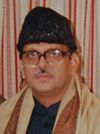
Vishwanath Pratap Singh
| 7th Prime Minister of India | |
|---|---|
| In office 2 December 1989 – 10 November 1990 |
|
| President | R. Venkatraman |
| Deputy | Chaudhary Devi Lal |
| Preceded by | Rajiv Gandhi |
| Succeeded by | Chandra Shekhar |
| Minister of Defence | |
| In office 2 December 1989 – 10 November 1990 |
|
| Preceded by | Krishna Chandra Pant |
| Succeeded by | Chandra Shekhar |
| In office 24 January 1987 – 12 April 1987 |
|
| Prime Minister | Rajiv Gandhi |
| Preceded by | Rajiv Gandhi |
| Succeeded by | Krishna Chandra Pant |
| Minister of Finance | |
| In office 31 December 1984 – 23 January 1987 |
|
| Prime Minister | Rajiv Gandhi |
| Preceded by | Pranab Mukherjee |
| Succeeded by | Rajiv Gandhi |
| Chief Minister of Uttar Pradesh | |
| In office 9 June 1980 – 19 July 1982 |
|
| Governor | Chandeshwar Prasad Narayan Singh |
| Preceded by | Banarsi Das |
| Succeeded by | Sripati Mishra |
| Personal details | |
| Born | Vishwanath Pratap Singh 25 June 1931 Allahabad, United Provinces, British India (now in Uttar Pradesh, India) |
| Died | 27 November 2008 (aged 77) New Delhi, India |
| Cause of death | Multiple myeloma |
| Political party | Jan Morcha (1987–1988; 2006–2008) |
| Other political affiliations |
Indian National Congress(Before 1987) Janata Dal (1988–2006) |
| Spouse(s) | Sita Kumari (m. 1955)[1] |
| Alma mater | Allahabad University University of Pune |
| Signature | |
Vishwanath Pratap Singh (25 June 1931 – 27 November 2008), was an Indian politician and government official, the 7th Prime Minister of India from 1989 to 1990. Singh is known for trying to improve the lot of India’s lower castes as a Prime Ministe
Singh was in a Rajput zamindar family ruling the Manda estate on 25 June 1931. He obtained his education from Colonel Brown Cambridge School, Dehra Dun and studied at Allahabad and Pune universities.
Singh became a Member of the Legislative Assembly of Uttar Pradesh in 1969 as a member of the Congress Party. He got elected to the Lok Sabha in 1971 and was appointed a Deputy Minister of Commerce by Prime Minister Indira Gandhi in 1974. He served as the Minister of Commerce in 1976–77.
He was appointed by Indira Gandhi as the Chief Minister of Uttar Pradesh in 1980, when Gandhi was re-elected after the Janata interlude. As Chief Minister (1980–82), he cracked down hard on dacoitry, a problem that was particularly severe in the rural districts of the south-west Uttar Pradesh. He received much favorable national publicity when he offered to resign following a self-professed failure to stamp out the problem, and again when he personally oversaw the surrender of some of the most feared dacoits of the area in 1983.
He resumed his post as Minister of Commerce in 1983. Singh was responsible for managing the coalition of the Left and BJP against Rajiv Gandhi to dethrone him in the 1989 elections. He is remembered for the important role that he played in 1989 that changed the course of Indian politics by becoming the Prime Minister of India and making the backwards and Dalits eligible for electoral politics. Unlike other Prime Ministers who came after him and made compromises, Singh acted boldly by issuing an arrest warrant against L. K. Advani midway through the Rath Yatra of Bharatiya Janata Party. He took a firm position regarding issues of corruption and anything damaging the secular fabric of the Indian state.
V. P. Singh died after a very long struggle with multiple myeloma (bone marrow cancer) and renal failure at Apollo Hospital in Delhi on 27 November 2008. He was cremated at Allahabad on the banks of the River Ganges on 29 November 2008, his son Ajeya Singh lighting the funeral pyre
Latest Govt Job & Exam Updates: